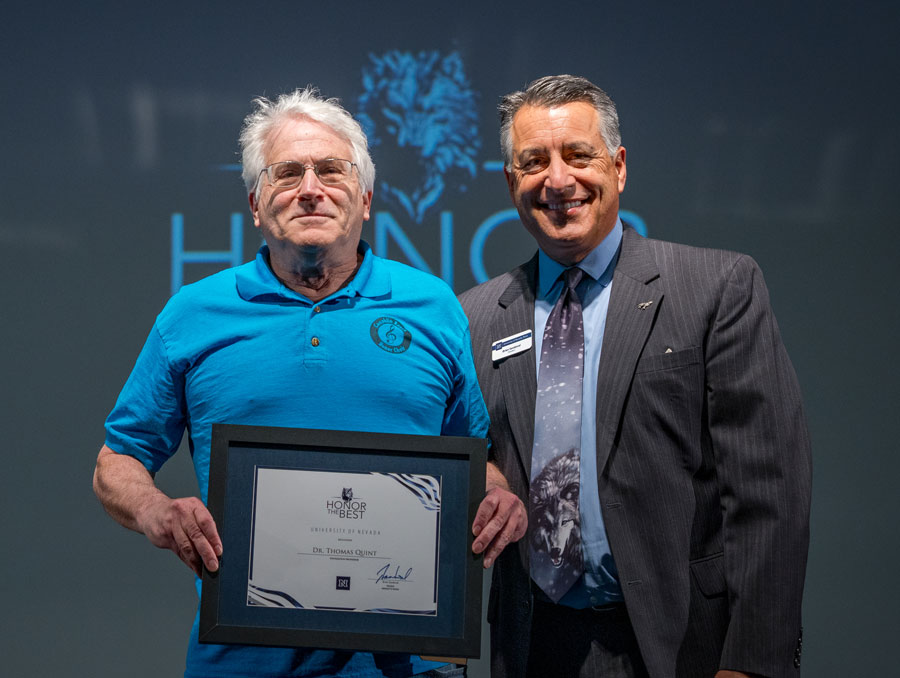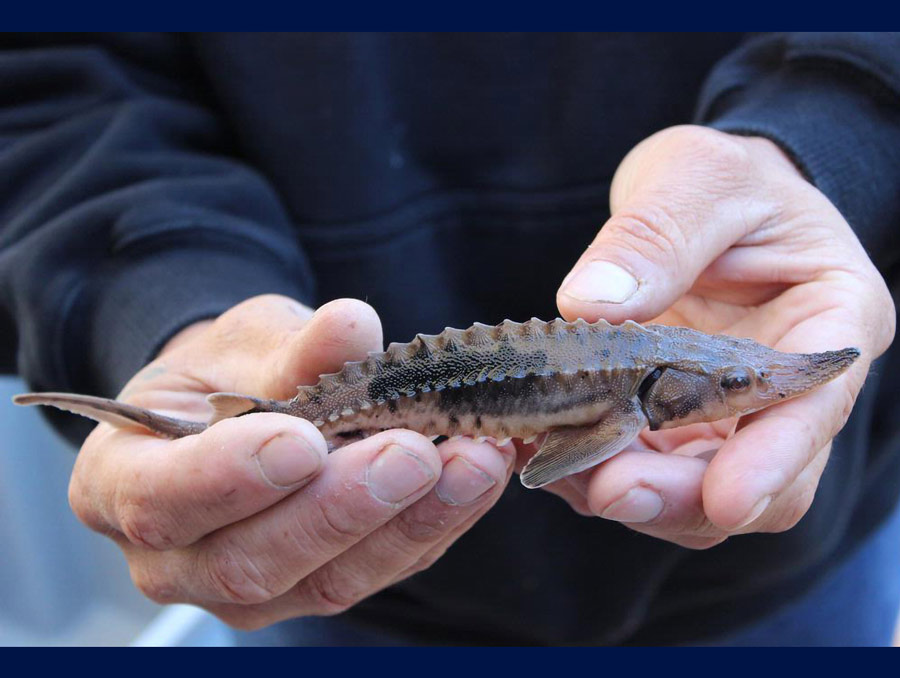This story was originally published in the 2024 edition of Discovery magazine, the College of Science's publication. This edition of Discovery celebrated the 20th anniversary of the College of Science.
In 2008, two faculty members, Michael Webster in the Department of Psychology and Grant Mastick in the Department of Biology, led a proposal for a new bachelor’s degree in neuroscience at the University. The development of the major, which has awarded over 800 degrees to students so far, is just one of several successful neuroscience initiatives started on campus in the last 16 years. The degree offering sparked the creation of the equally successful neuroscience graduate program, a National Institutes of Health (NIH) center grant with tens of millions of dollars for research equipment, funding for faculty and students, a burgeoning number of exceptional new neuroscience faculty leading new discoveries in the field, and a new formal Institute for Neuroscience to lead the University’s continued growth in the discipline.
"I think we're at the cusp of a radical transformation in society because of the growth of data science and computational neuroscience."
The NIH center grant is funded through the Institutional Development Award (IDeA) program of the NIH, which is designed to grow research capacity in states with historically low NIH support. The Center of Biomedical Research Excellence (COBRE) award is the basic research arm of the IDeA program and has awarded $25 million over 15 years to build faculty and research infrastructure at the University, helping the institution to become a powerful contributor to neuroscience advances. The University currently also has a COBRE award for cardiovascular health based in the School of Medicine. Webster, Foundation Professor in the psychology department, was awarded the neuroscience COBRE in 2012, and so far the funding has supported more than 30 junior faculty from several departments across campus.
In 2015, a master’s and doctoral degree Graduate Program in Integrative Neuroscience was also launched, again led by Webster and Mastick. Like the undergraduate degree program, the graduate program has seen explosive growth. There are currently 40 active graduate students in the program and more than 70 affiliated faculty.
"I’m constantly amazed by the caliber of our students at both the undergraduate and graduate levels," Webster said.
Research equipment and infrastructure lands on campus
The COBRE for Integrative Neuroscience has also brought several "core" research facilities to campus, including a neuroimaging core with technology like high-density electroencephalography (EEG) and functional magnetic resonance imaging (fMRI), tools which are essential for modern research in cognitive neuroscience. The fMRI facility was made possible by a partnership between the University and Renown Health. Additional cores include a cellular and molecular imaging and microscopy core, a virtual and augmented reality core, and a computational modeling and analysis core that provides infrastructure and technical expertise to leverage high-performance computing and artificial intelligence (AI) in neuroscience research. These cores are housed in the departments of psychology, biology and computer science, while the fMRI facility is located at Renown’s imaging center. Importantly, these cores are essential not only to the University’s research impact, but also to its teaching mission.
"In order to have successful programs at both the graduate and undergraduate level, students need to have the ability to work with modern neuroscience techniques," Webster said. "In addition to being essential for research, their contribution to education is also invaluable."
The neuroscience faculty offer numerous research opportunities available and accessible to undergraduate students, which has been the goal from the start.
"We teach students a lot about ideas and approaches," Webster said. "But they also need the experience of applying these methods to actual questions. It’s an incredibly important part of their training."
Webster also points out the benefits of research experience for students interested in applying for graduate school. Undergraduate research gives students a chance to learn firsthand what doing science is really like and gives them an advantage when they’re applying for graduate school.
"When we’re looking at applicants for graduate school, it’s a plus to see that the person has already tried out research, that they know what it's about and that they're motivated to and interested in pursuing research," Webster said.
At the time the neuroscience major was created, psychology was housed in the College of Liberal Arts. By pairing with biology in the College of Science, the major was the first to span two colleges, and became a prototype for developing other interdisciplinary majors. However, in 2019, the Department of Psychology migrated to the College of Science.
"The move to the College of Science has been an enormous advantage to us and we're extremely grateful," Webster said. "We felt really welcomed and supported there."
Neuroscience: the common discipline
Interdisciplinary research has become increasingly popular among most fields, including neuroscience.
"Science itself is really fluid," Webster said. "It's widely recognized that important breakthroughs in science are probably going to come from bringing together people that have very different approaches and perspectives."
Neuroscience is the hallmark of an interdisciplinary field, and draws from many fields, from philosophy to physics.
"I don't believe there's any discipline that we have on campus that doesn't connect somehow with neuroscience," Webster said. "And I think that the government and funding agencies recognize that, too."
The broader field of neuroscience is becoming a priority for funding agencies like the NIH. In part, this is due to critical health issues like neurodegenerative diseases. However, beyond health, neuroscience research is useful for addressing everything from engineering to societal issues. For example, AI draws heavily on ideas about how biological brains work. In the coming years, Webster and his colleagues want to keep up with the AI revolution by incorporating more data science courses and research in the neuroscience program.
"I see that as a really critical connection to neuroscience," Webster said. "I think we're at the cusp of a radical transformation in society because of the growth of data science and computational neuroscience."
Webster acknowledged colleagues Anna Panorska in the math department and Emily Hand in the computer science department, who are working on developing more cross-disciplinary data science courses for the University, which the neuroscience programs hope to draw on.
Establishing an institute
As the second phase of the COBRE renewal period approached, Webster developed a proposal to build a permanent home for the neuroscience initiatives on campus through the establishment of an Institute for Neuroscience. Jim Kenyon, the former senior associate dean for research at the medical school, was excited enough about the idea that he came out of retirement to lead the institute.
Kenyon has pushed the institute toward growth and increased capacity by helping faculty apply for additional NIH funding, particularly for students from underrepresented backgrounds, including the successful undergraduate NIH Maximizing Access to Research Careers (MARC) grant. The first cohort of MARC students graduated in spring.
Kenyon also recently applied for a graduate education grant that Webster said has the potential to vastly improve the graduate curriculum and opportunities for neuroscience and all the biomedical sciences. The proposal is now pending.
Another successful NIH proposal, led by Mariann Weierich, James K. and Lois Merritt Mikawa Distinguished Professor in Clinical Psychology, resulted in the Enhancing Neuroscience Diversity through Undergraduate Research Education program (also known as Nevada ENDURE) being established on campus, with its own successful student cohorts who have graduated and begun their journey toward earning doctoral degrees.
The Institute for Neuroscience ensures advocacy for the neuroscience programs, since the interdisciplinary structure means there isn’t a department to represent the program, like many other disciplines on campus have.
"We really need some kind of administrative structure to get neuroscience faculty across campus talking to each other and networking and making sure we keep building these different interdisciplinary opportunities," Webster said.
Webster believes neuroscience is well-positioned to continue its growth across the University after the COBRE grant ends.
"I'm really proud of the fact that we've been able to create opportunities for students that didn't exist here before," Webster said about on how far the program has come. "In terms of research, I think we have really elevated the University’s impact."
Webster reflected on the research success of the neuroscience program in the context of the University’s Carnegie R1 research status. There are now some research funding programs that the University is no longer able to apply for because it has exceeded the maximum research funds an institution can have to apply for them.
"I believe that neuroscience played its part in helping elevate the University’s research impact, and that the high demand for training and research in the brain sciences will only continue to grow," Webster said.















